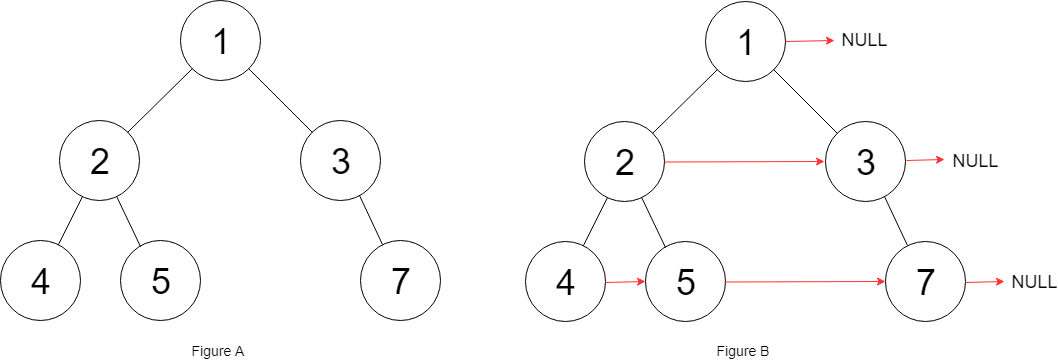LC105 Construct Binary Tree from Preorder and Inorder Traversal
Problem
Given preorder and inorder traversal of a tree, construct the binary tree.
Note:
You may assume that duplicates do not exist in the tree.For example, given
2
inorder = [9,3,15,20,7]Return the following binary tree:
2
3
4
5
/ \
9 20
/ \
15 7
Think
递归,preorder首元素为根,以这个作为区分,可以得到左右子树的preorder和inorder
Code
1 | TreeNode* buildTree(vector<int>& preorder, vector<int>& inorder) { |
LC106 Construct Binary Tree from Inorder and Postorder Traversal
Problem
Given inorder and postorder traversal of a tree, construct the binary tree.
Note:
You may assume that duplicates do not exist in the tree.For example, given
2
postorder = [9,15,7,20,3]Return the following binary tree:
2
3
4
5
/ \
9 20
/ \
15 7
Think
和上一题类似
Code
1 | TreeNode* buildTree(vector<int>& inorder, vector<int>& postorder) { |
LC108 Convert Sorted Array to Binary Search Tree
Problem
Given an array where elements are sorted in ascending order, convert it to a height balanced BST.
For this problem, a height-balanced binary tree is defined as a binary tree in which the depth of the two subtrees of every node never differ by more than 1.
Example:
2
3
4
5
6
7
8
9
One possible answer is: [0,-3,9,-10,null,5], which represents the following height balanced BST:
0
/ \
-3 9
/ /
-10 5
Think
类似上一题
Code
1 | TreeNode* sortedArrayToBST(vector<int>& nums) { |
LC109 Convert Sorted List to Binary Search Tree
Problem
Given a singly linked list where elements are sorted in ascending order, convert it to a height balanced BST.
For this problem, a height-balanced binary tree is defined as a binary tree in which the depth of the two subtrees of every node never differ by more than 1.
Example:
2
3
4
5
6
7
8
9
One possible answer is: [0,-3,9,-10,null,5], which represents the following height balanced BST:
0
/ \
-3 9
/ /
-10 5
Think
采用类似于数组的方式,首先求出链表的长度,然后首先以当前节点建立一个一个节点,然后让左子节点等于left到mid - 1的部分求得的treenode,右子节点等于mid + 1到right的部分求得的treenode,在这里要注意由于里面需要使用链表节点,要先存储最初始的head节点。
Code
1 | ListNode* head; |
LC112 Path Sum
Problem
Given a binary tree and a sum, determine if the tree has a root-to-leaf path such that adding up all the values along the path equals the given sum.
Note: A leaf is a node with no children.
Example:
Given the below binary tree and
sum = 22,
2
3
4
5
6
7
/ \
4 8
/ / \
11 13 4
/ \ \
7 2 1return true, as there exist a root-to-leaf path
5->4->11->2which sum is 22.
Think
递归DFS
Code
1 | bool hasPathSum(TreeNode* root, int sum) { |
LC113 Path Sum II
Problem
Given a binary tree and a sum, find all root-to-leaf paths where each path’s sum equals the given sum.
Note: A leaf is a node with no children.
Example:
Given the below binary tree and
sum = 22,
2
3
4
5
6
7
/ \
4 8
/ / \
11 13 4
/ \ / \
7 2 5 1Return:
2
3
4
[5,4,11,2],
[5,8,4,5]
]
Think
递归DFS,其中带上结果数组res
Code
1 | vector<vector<int>> pathSum(TreeNode* root, int sum) { |
LC114 Flatten Binary Tree to Linked List
Problem
Given a binary tree, flatten it to a linked list in-place.
For example, given the following tree:
2
3
4
5
/ \
2 5
/ \ \
3 4 6The flattened tree should look like:
2
3
4
5
6
7
8
9
10
11
\
2
\
3
\
4
\
5
\
6
Think
递归,首先将左右子树flatten,然后将现在的右子树连到左子树最下方,将左子树置于当前节点的右子节点处即可。
Code
1 | void flatten(TreeNode* root) { |
LC116 Populating Next Right Pointers in Each Node
Problem
You are given a perfect binary tree where all leaves are on the same level, and every parent has two children. The binary tree has the following definition:
2
3
4
5
6
int val;
Node *left;
Node *right;
Node *next;
}Populate each next pointer to point to its next right node. If there is no next right node, the next pointer should be set to
NULL.Initially, all next pointers are set to
NULL.Follow up:
- You may only use constant extra space.
- Recursive approach is fine, you may assume implicit stack space does not count as extra space for this problem.
Example 1:
2
3
Output: [1,#,2,3,#,4,5,6,7,#]
Explanation: Given the above perfect binary tree (Figure A), your function should populate each next pointer to point to its next right node, just like in Figure B. The serialized output is in level order as connected by the next pointers, with '#' signifying the end of each level.Constraints:
- The number of nodes in the given tree is less than
4096.-1000 <= node.val <= 1000
Think
- Approach 1
BFS层序遍历
- Approach 2
按层遍历,使用leftmost表示上一层的最左节点
Code
- Approach 1
1 | Node* connect(Node* root) { |
- Approach 2
1 | Node* connect(Node* root) { |
LC117 Populating Next Right Pointers in Each Node II
Problem
Given a binary tree
2
3
4
5
6
int val;
Node *left;
Node *right;
Node *next;
}Populate each next pointer to point to its next right node. If there is no next right node, the next pointer should be set to
NULL.Initially, all next pointers are set to
NULL.Follow up:
- You may only use constant extra space.
- Recursive approach is fine, you may assume implicit stack space does not count as extra space for this problem.
Example 1:
2
3
Output: [1,#,2,3,#,4,5,7,#]
Explanation: Given the above binary tree (Figure A), your function should populate each next pointer to point to its next right node, just like in Figure B. The serialized output is in level order as connected by the next pointers, with '#' signifying the end of each level.Constraints:
- The number of nodes in the given tree is less than
6000.-100 <= node.val <= 100
Think
BFS层序遍历
Code
1 | Node* connect(Node* root) { |
LC124 Binary Tree Maximum Path Sum
Problem
Given a non-empty binary tree, find the maximum path sum.
For this problem, a path is defined as any sequence of nodes from some starting node to any node in the tree along the parent-child connections. The path must contain at least one node and does not need to go through the root.
Example 1:
2
3
4
5
6
7
1
/ \
2 3
Output: 6Example 2:
2
3
4
5
6
7
8
9
-10
/ \
9 20
/ \
15 7
Output: 42
Think
可以转化为计算每一个节点处的最大左路径和最大右路径的和,再加上节点本身的值,因此可以使用一个递归函数来求解这个路径(某一个节点到叶节点的最大路径和)。
Code
1 | int res = INT_MIN; |
LC129 Sum Root to Leaf Numbers
Problem
Given a binary tree containing digits from
0-9only, each root-to-leaf path could represent a number.An example is the root-to-leaf path
1->2->3which represents the number123.Find the total sum of all root-to-leaf numbers.
Note: A leaf is a node with no children.
Example:
2
3
4
5
6
7
8
9
1
/ \
2 3
Output: 25
Explanation:
The root-to-leaf path 1->2 represents the number 12.
The root-to-leaf path 1->3 represents the number 13.
Therefore, sum = 12 + 13 = 25.Example 2:
2
3
4
5
6
7
8
9
10
11
12
4
/ \
9 0
/ \
5 1
Output: 1026
Explanation:
The root-to-leaf path 4->9->5 represents the number 495.
The root-to-leaf path 4->9->1 represents the number 491.
The root-to-leaf path 4->0 represents the number 40.
Therefore, sum = 495 + 491 + 40 = 1026.
Think
DFS递归,每次cur加上当前节点的值,然后乘上10传递给两个子树
Code
1 | int sumNumbers(TreeNode* root) { |
LC257 Binary Tree Paths
Problem
Given a binary tree, return all root-to-leaf paths.
Note: A leaf is a node with no children.
Example:
2
3
4
5
6
7
8
9
10
11
1
/ \
2 3
\
5
Output: ["1->2->5", "1->3"]
Explanation: All root-to-leaf paths are: 1->2->5, 1->3
Think
递归DFS
Code
1 | vector<string> binaryTreePaths(TreeNode* root) { |
LC332 Reconstruct Itinerary
Problem
Given a list of airline tickets represented by pairs of departure and arrival airports
[from, to], reconstruct the itinerary in order. All of the tickets belong to a man who departs fromJFK. Thus, the itinerary must begin withJFK.Note:
- If there are multiple valid itineraries, you should return the itinerary that has the smallest lexical order when read as a single string. For example, the itinerary
["JFK", "LGA"]has a smaller lexical order than["JFK", "LGB"].- All airports are represented by three capital letters (IATA code).
- You may assume all tickets form at least one valid itinerary.
Example 1:
2
Output: ["JFK", "MUC", "LHR", "SFO", "SJC"]Example 2:
2
3
4
Output: ["JFK","ATL","JFK","SFO","ATL","SFO"]
Explanation: Another possible reconstruction is ["JFK","SFO","ATL","JFK","ATL","SFO"].
But it is larger in lexical order.
Think
DFS + 栈,首先用multiset map存放每一条边,然后建立一个栈,首先将“JFK”存进栈,当栈不为空时:
设栈顶元素为s,如果map[t]为空,表明之后都不会再访问这个点,因此把这个点从栈中取出来放入结果数组中,否则将当前到达的节点放入栈中,并multiset map中删除对应元素
Code
1 | vector<string> findItinerary(vector<vector<string>>& tickets) { |
LC337 House Robber III
Problem
The thief has found himself a new place for his thievery again. There is only one entrance to this area, called the “root.” Besides the root, each house has one and only one parent house. After a tour, the smart thief realized that “all houses in this place forms a binary tree”. It will automatically contact the police if two directly-linked houses were broken into on the same night.
Determine the maximum amount of money the thief can rob tonight without alerting the police.
Example 1:
2
3
4
5
6
7
8
9
10
3
/ \
2 3
\ \
3 1
Output: 7
Explanation: Maximum amount of money the thief can rob = 3 + 3 + 1 = 7.Example 2:
2
3
4
5
6
7
8
9
10
3
/ \
4 5
/ \ \
1 3 1
Output: 9
Explanation: Maximum amount of money the thief can rob = 4 + 5 = 9.
Think
递归,当前节点node处开始抢,所能拿到的最大数值为node->val + ll + lr + rl + rr或者l + r
Code
1 | int rob(TreeNode* root) { |
LC394 Decode String
Problem
Given an encoded string, return its decoded string.
The encoding rule is:
k[encoded_string], where the encoded_stringinside the square brackets is being repeated exactly k times. Note that kis guaranteed to be a positive integer.You may assume that the input string is always valid; No extra white spaces, square brackets are well-formed, etc.
Furthermore, you may assume that the original data does not contain any digits and that digits are only for those repeat numbers, k. For example, there won’t be input like
3aor2[4].Example 1:
2
Output: "aaabcbc"Example 2:
2
Output: "accaccacc"Example 3:
2
Output: "abcabccdcdcdef"Example 4:
2
Output: "abccdcdcdxyz"
Think
递归,每一次的结果等于重复外围的数字次数的内部的内容,利用一个全局变量i来进行s的遍历。
Code
1 | string decodeString(string s) { |
Review
DFS一般是和递归联系起来的,主要包括如下内容的递归:
- 树上的递归,即左右子树存在相同的结构;
- 内部最小子结构的递归;


